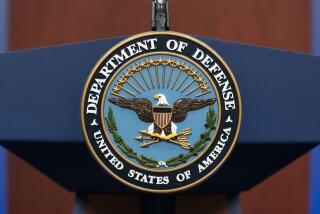Getting Ready to Go to War
- Share via
ABOARD THE JOHN C. STENNIS, off Southern California--This nuclear-powered aircraft carrier and the eight ships that make up its battle group are training for the next phase of the war on terrorism.
It is a phase that could look a lot different from the first foray, which has emphasized high-altitude bombing of terrorist targets and a limited use of ground troops.
Judging from the training underway here, the military is anticipating a possible conflict that is prolonged, involves a larger number of ground troops and may spread to countries other than Afghanistan.
While the Navy will not confirm when or where the San Diego-based battle group is going, it is an open secret among enlisted personneland junior officers that the group will deploy this month to relieve the carrier Carl Vinson in the Arabian Sea.
“I think all the guys want a piece of” the terrorists, said Capt. R.C. Thompson, an F-18 pilot and commander of the Stennis air group, which gives him the privilege of leading the first airstrike. “I think it’s an honor to collect a debt on behalf of 280 million Americans.”
In preparation for the deployment, training sessions have been “tweaked” to inject verisimilitude.
The Stennis is moving farther from land than it does normally in such training, to give F-18 Hornet and F-14 Tomcat crews the experience of a longer flight before dropping their bombs, much like the pilots now hitting targets in Afghanistan.
Training to Support Ground Troops
A common target will be the Chocolate Mountain bombing range in eastern Riverside County, which shares topographic similarities with regions of Afghanistan.
Training has also been increased in providing close air support for ground troops by swooping in at low levels to bomb and strafe.
“We try not to get down there and grovel with the bullets,” said Thompson, “but if there are Marines down there and they need help, we’re going down there.”
AE-6B Prowlers, electronic warfare planes, are practicing missions in which they jam enemy radar installations and disrupt electronic communications.
Such missions have not been needed to a large degree in Afghanistan, which largely lacks the kind of sophisticated air defense systems that the Prowler is designed to disable.
“There are still other countries on the ‘bad boy’ list, and so if we go to some of those, our significance could well rise dramatically,” said Cmdr. Rick Postera, executive officer of a Prowler squadron from Whidbey Island, Wash.
Along with changing predeployment “scenarios,” the Stennis battle group is attempting to shorten the time needed for training--half of the Stennis’ crew has never participated in a Western Pacific deployment--and for maintenance of the ship.
The group had been set to deploy in mid-January. But with the military needing two or more carriers in the Arabian Sea region at all times, a predeployment “final exam” that often takes two weeks or more is set to be completed within seven days.
Many Changes From Routine Deployment
The goal is to see whether crews can be ready for redeployment faster and with less shore leave, which is seen as a preferred alternative to lengthening the deployment past the standard six months.
“It’s going to be possible, but it’s going to be a challenge,” said Cmdr. Joe Stuyvesant, acting as one of the evaluators of the training exercise, which began Thursday. “We need to be able to sustain a presence, and that means shortening some things, changing others.”
There are other changes, as well, that indicate how this deployment is markedly different from routine Western Pacific missions.
The carrier’s hospital has laid in a store of antibiotics (including Cipro) and antidotes in case the ship is attacked with anthrax or nerve agents. A metal detector has been installed for the first time to check all sailors as they board the ship for unauthorized weapons.
And Osama bin Laden’s grimacing image is virtually everywhere: on shipboard videos that advise sailors on security measures, and on the classic “loose lips sink ships” posters.
As the battle group assembled air squadrons from San Diego; Lemoore, Calif.; Whidbey Island; and Virginia Beach, Va., a premium was set on experienced pilots who have flown “hot” missions in the Persian Gulf.
“We had three very experienced guys, so we held up their transfers so we could take that experience with us,” said Lt. Cmdr. Tony Knight, an F-18 pilot from Lemoore. “After Sept. 11, everybody wanted to go. The only guy who opted out, well, he’s persona non grata with us now.”
Personnel Have Seen Terrorism’s Effects
The arrival of the Stennis and its battle group will also bring something intangible but significant to the war: large numbers of military personnel who have either seen the damage at the Pentagon and World Trade Center or watched the trauma inflicted on the country. The carriers and pilots now in the region were either already at sea Sept. 11 or deployed within days.
Thompson plans to chalk the message on his first bomb with the flight numbers of two of the planes that were hijacked by the terrorists.
Cmdr. Owen Honors, an F-14 pilot from a squadron in Virginia, went to New York to see the rubble in lower Manhattan. He says he’ll be thinking about that devastation when he flies his first mission.
Honors says his colleagues are ready, even with the shortened training schedule. But the weeklong exercise will not be wasted, he said.
“I think of it as one more opportunity to sharpen the knife a little bit,” he said.
More to Read
Sign up for Essential California
The most important California stories and recommendations in your inbox every morning.
You may occasionally receive promotional content from the Los Angeles Times.













